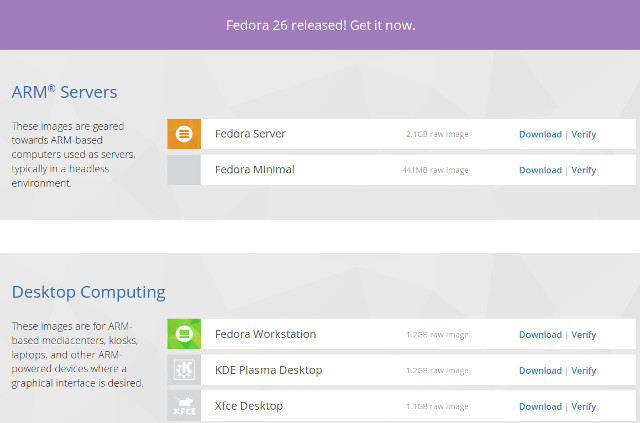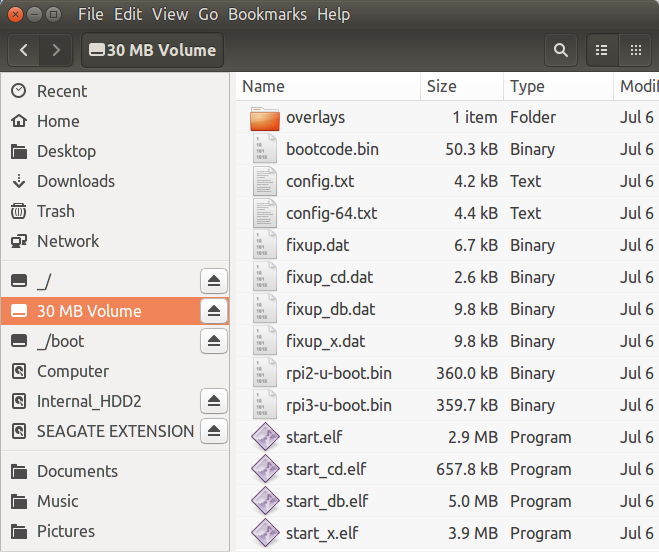The decision to use device tree in Linux occurred several years ago, after Linus Torvalds complained that Linux on ARM was a mess, with the ultimate goal of providing a unified ARM kernel for all hardware. Most machine specific board files in arch/arm/mach-xxx/ are now gone from the Linux kernel, being replaced by device tree files, and in many case you simply need to replace the DTB (Device Tree Binary) file from an operating system to run on different hardware platforms. However, this is not always that easy as U-boot still often differ between boards / devices, so it’s quite frequent to distribute different firmware / OS images per board. Fedora has taken another approach, as the developers are instead distributing a single Fedora 26 OS ARMv7 image, together with an installation script.
 Images for 64-bit ARM (Aarch64) are a little different since they are designed for SBSA compliant servers, so a single image will work on any server leveraging UEFI / ACPI implementation on the hardware. So what follows is specific to ARMv7 hard-float images as explained in the Wiki.
Images for 64-bit ARM (Aarch64) are a little different since they are designed for SBSA compliant servers, so a single image will work on any server leveraging UEFI / ACPI implementation on the hardware. So what follows is specific to ARMv7 hard-float images as explained in the Wiki.
You’ll need to install Fedora Arm installer after downloading one of the Fedora 26 images. This requires an Fedora machine, and since I’m running Ubuntu 16.04, and don’t want to setup a Fedora virtual machine in Virtualbox, I used docker instead right inside Ubuntu as it’s much faster to do:
|
1 2 3 4 |
sudo apt install docker sudo docker pull fedora sudo umount /dev/sdd* sudo docker run -i -t -v /media/hdd:/mnt --device==/dev/sdd --device=/dev/sdd3 fedora:latest /bin/bash |
The last line requires some explanation. /media/hdd is the mount point of the storage device on the host where I download the Fedora image and that will be accessible through /mnt in docker, /dev/sdd is my micro SD card device, while /dev/sdd3 will be the rootfs partition.Note that it took me a while to get that right, and I’m not sure it works for all targets (other other /dev/sddx are also needed), so using an actual Fedora 26 installation would be easier. The rest of the instructions below are not specific to docker.
I could then install the Fedora ARM Installer and the required xz & file packages…
|
1 |
dnf install fedora-arm-installer xz file |
…and check the usage:
|
1 2 3 4 5 6 7 8 9 10 11 12 13 14 15 16 17 18 |
[root@f2a5f32ac868 /]# fedora-arm-image-installer Usage: fedora-arm-image-installer --image=IMAGE - xz compressed image file name --target=TARGET - target board --media=DEVICE - media device file (/dev/[sdX|mmcblkX]) --norootpass - Remove the root password -y - Assumes yes, will not wait for confirmation --version - Display version and exit --resizefs - Resize root filesystem to fill media device --addconsole - Add system console to extlinux.conf --addkey= - /path/to/ssh-public-key --supported-boards Example: fedora-arm-image-installer --image=Fedora-Rawhide.xz --target=Bananapi --media=/dev/mmcblk0 For list of supported boards please check SUPPORTED-BOARDS file. |
Let’s see how many boards are supported in /usr/share/doc/fedora-arm-installer/SUPPORTED-BOARDS file:
AllWinner Devices:
A10-OLinuXino-Lime A10s-OLinuXino-M A13-OLinuXino A13-OLinuXinoM
A20-OLinuXino-Lime A20-OLinuXino-Lime2 A20-OLinuXino_MICRO
A20-Olimex-SOM-EVB Ampe_A76 Auxtek-T003 Auxtek-T004 Bananapi Bananapro CHIP
CSQ_CS908 Chuwi_V7_CW0825 Colombus Cubieboard Cubieboard2 Cubietruck
Cubietruck_plus Hummingbird_A31 Hyundai_A7HD Itead_Ibox_A20 Lamobo_R1
Linksprite_pcDuino Linksprite_pcDuino3 Linksprite_pcDuino3_Nano MK808C
MSI_Primo73 MSI_Primo81 Marsboard_A10 Mele_A1000 Mele_A1000G_quad Mele_I7
Mele_M3 Mele_M5 Mele_M9 Mini-X Orangepi Orangepi_mini Sinlinx_SinA31s
UTOO_P66 Wexler_TAB7200 Wits_Pro_A20_DKT Yones_Toptech_BS1078_V2 ba10_tv_box
colorfly_e708_q1 difrnce_dit4350 dserve_dsrv9703c i12-tvbox iNet_86VS
icnova-a20-swac inet86dz jesurun_q5 mk802 mk802_a10s mk802ii orangepi_2
orangepi_lite orangepi_pc orangepi_plus polaroid_mid2809pxe04
pov_protab2_ips9 q8_a13_tablet q8_a23_tablet_800x480 q8_a33_tablet_1024x600
q8_a33_tablet_800x480 r7-tv-dongle sunxi_Gemei_G9MX6 Devices:
cm_fx6 mx6cuboxi novena riotboard wandboardOMAP Devices:
am335x_boneblack am57xx_evm kc1 omap3_beagle omap4_panda omap5_uevmMVEBU Devices:
clearfogST Devices:
stih410-b2260Other Devices:
jetson-tk1 rpi2 rpi3 trimslice
So we’ve got a list of device to choose from. For example, if you wanted to install Fedora 26 server in a micro SD card for Raspberry Pi 3, you’d run something like:
|
1 |
fedora-arm-image-installer --image=/mnt/Downloads/Fedora-Server-armhfp-26-1.5-sda.raw.xz --target=rpi3 --media=/dev/sdd --resizefs |
You’ll then be ask to confirm:
|
1 2 3 4 5 6 7 8 9 10 11 12 13 14 15 16 17 |
===================================================== = Selected Image: = /mnt/Downloads/Fedora-Server-armhfp-26-1.5-sda.raw.xz = Selected Media : /dev/sdd = U-Boot Target : rpi3 = Root partition will be resized ===================================================== ***************************************************** ***************************************************** ******** WARNING! ALL DATA WILL BE DESTROYED ******** ***************************************************** ***************************************************** Type 'YES' to proceed, anything else to exit now = Proceed? YES |
The full process will take several minutes, and at the end you’ll get “_/” rootfs partition, “_/boot ” partition, and a “30 MB volume” with u-boot, config,etc…

I did not try the micro SD card in Raspberry Pi 3 board myself, because Geek Till It Hertz has already done it successfully on both RPi 3 and Banana Pi boards as shown in the video below.
He also showed the boards run Linux 4.11.8 version, but that can be upgraded with dnf update to Linux 4.11.11, just as on his Fedora 26 installation on a x86-64 computer.

Jean-Luc started CNX Software in 2010 as a part-time endeavor, before quitting his job as a software engineering manager, and starting to write daily news, and reviews full time later in 2011.
Support CNX Software! Donate via cryptocurrencies, become a Patron on Patreon, or purchase goods on Amazon or Aliexpress




